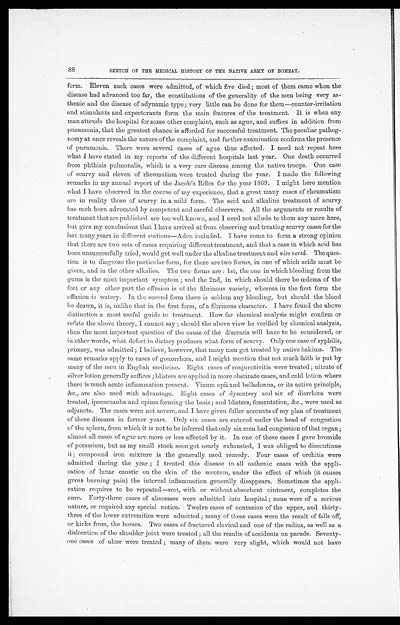Medicine - Institutions > Army health reports and medical documents > Sketch of the medical history of the native army of Bombay > Sketch of the medical history of the native army of Bombay, for the year 1870
(40) Page 88
Download files
Individual page:
Thumbnail gallery: Grid view | List view

88
SKETCH OF THE MEDICAL HISTORY OF THE NATIVE ARMY OF BOMBAY.
form, Eleven such cases were admitted, of which five died; most of them came when the
disease had advanced too far, the constitutions of the generality of the men being very as-
thenic and the disease of adynamic type; very little can be done for them—counter-irritation
and stimulants and expectorants form the main features of the treatment. It is when any
man attends the hospital for some other complaint, such as ague, and suffers in addition from
pneumonia, that the greatest chance is afforded for successful treatment. The peculiar pathog-
nomy at once reveals the nature of the complaint, and further examination confirms the presence
of pneumonia. There were several cases of ague thus affected. I need not repeat here
what I have stated in my reports of the different hospitals last year. One death occurred
from phthisis pulmonalis, which is a very rare disease among the native troops. One case
of scurvy and eleven of rheumatism were treated during the year. I made the following
remarks in my annual report of the Jacob's Rifles for the year 1869. I might here mention
what I have observed in the course of my experience, that a great many cases of rheumatism
are in reality those of scurvy in a mild form. The acid and alkaline treatment of scurvy
has each been advocated by competent and careful observers. All the arguments or results of
treatment that are published are too well known, and I need not allude to them any more here,
but give my conclusions that I have arrived at from observing and treating scurvy cases for the
last many years in different stations—Aden included. I have come to form a strong opinion
that there are two sets of cases requiring different treatment, and that a case in which acid has
been unsuccessfully tried, would get well under the alkaline treatment and vice versâ. The ques-
-tion is to diagnoze the particular form, for there are two forms, in one of which acids must be
given, and in the other alkalies. The two forms are: 1st, the one in which bleeding from the
gums is the most important symptom; and the 2nd, in which should there be œdema of the
feet or any other part the effusion is of the fibrinous variety, whereas in the first form the
effusion is watery. In the second form there is seldom any bleeding, but should the blood
be drawn, it is, unlike that in the first form, of a fibrinous character. I have found the above
distinction a most useful guide to treatment. How far chemical analysis might confirm or
refute the above theory, I cannot say; should the above view be verified by chemical analysis,
then the most important question of the cause of the discrasis will have to be considered, or
in other words, what defect in dietary produces what form of scurvy. Only one case of syphilis,
primary, was admitted; I believe, however, that many men get treated by native hakims. The
same remarks apply to cases of gonorrhœa, and I might mention that not much faith is put by
many of the men in English medicine. Eight cases of conjunctivitis were treated; nitrate of
silver lotion generally suffices; blisters are applied in more obstinate cases, and cold lotion where
there is much acute inflammation present. Vinum opii and belladonna., or its active principle,
&c., are also used with advantage. Eight cases of dysentery and six of diarrhœa were
treated, ipecacuanha and opium forming the basis; and blisters, fomentation, &c., were used as
adjuncts. The cases were not severe, and I have given fuller accounts of my plan of treatment
of these diseases in former years. Only six cases are entered under the head of congestion
of the spleen, from which it is not to be inferred that only six men had congestion of that organ;
almost all cases of ague are more or less affected by it. In one of these cases I gave bromide
of potassium, but as my small stock soon got nearly exhausted, I was obliged to discontinue
it; compound iron mixture is the generally used remedy. Four cases of orchitis were
admitted during the year; I treated this disease in all asthenic cases with the appli-
cation of lunar caustic on the skin of the scrotum, under the effect of which (it causes
great burning pain) the internal inflammation generally disappears. Sometimes the appli-
cation requires to be repeated—rest, with or without absorbent ointment, completes the
cure. Forty-three cases of abscesses were admitted into hospital; none were of a serious
nature, or required any special notice. Twelve cases of contusion of the upper, and thirty-
three of the lower extremities were admitted; many of these cases were the result of falls off,
or kicks from, the horses. Two cases of fractured clavical and one of the radius, as well as a
dislocation of the shoulder joint were treated; all the results of accidents on parade. Seventy-
one cases of ulcer were treated; many of them were very slight, which would not have
Set display mode to: Large image | Zoom image | Transcription
Images and transcriptions on this page, including medium image downloads, may be used under the Creative Commons Attribution 4.0 International Licence unless otherwise stated. ![]()
| Permanent URL | https://digital.nls.uk/75007236 |
|---|




